Abstract
Highly specific antisera to triiodothyronine (T3) were prepared by immunization of rabbits with T3-bovine serum albumin conjugates. Antisera with T3 binding capacity of up to 600 ng/ml were obtained. The ability of various thyronine derivatives to inhibit the binding of T3-125I to anti-T3 serum was found to vary considerably. l-T3, d-T3 and several triiodoanalogues were potent inhibitors of the reaction. Little inhibition of T3-125I binding was produced by l-thyroxine (T4) or other tetraiodo- analogues, thyronine or iodotyrosines. Chromatography of several T4 preparations indicated that most of their very slight activity could be ascribed to contamination with T3.
Successful assay of T3 in serum was accomplished by the addition of diphenylhydantoin to the assay system. Under these circumstances, recovery of T3 added to serum was excellent, and addition of T4 was without significant effect. Serum T3 concentrations in normal subjects averaged 145 ±25 ng/100 ml (sd). Increased concentrations (429 ±146 ng/100 ml) were observed in hyperthyroid patients whereas those with hypothyroidism had serum T3 levels of 99 ±24 ng/100 ml. Elevated T3 concentrations were found also in hypothyroid patients receiving 25 μg or more of T3 daily and in those receiving 300 μg of T4 daily. Serial measurements of T3 concentrations in subjects after oral T3 administration revealed peak T3 concentrations 2-4 hr after T3 administration. Intramuscular administration of thyrotropin (TSH) resulted in earlier and more pronounced increases in serum T3 than in serum T4 concentrations.
Triiodothyronine (T3)1 was recognized to be a biologically active secretory product of the thyroid gland over a decade ago (1). Recent studies have indicated that it is formed extrathyroidally as well (2, 3). Nevertheless, relatively little information concerning the role of T3 secretion in different thyroid disorders has been accumulated until very recently. Methods for the measurement of T3 which require its extraction from plasma, and often its separation from thyroxine as well, have been described by several investigators (4-11). These methods have proven useful, but they are relatively complicated, the number of samples that can be assayed is limited, and they may be affected by in vitro deiodination of thyroxine. More recently the radioimmunoassay technique has been applied to the measurement of T3. Several preliminary reports have appeared describing the preparation of antibody to triiodothyronine by immunization of animals with T3-protein conjugates and its use for the measurement of T3 in serum (12-15). The present report describes the development of a radioimmunoassay for the measurement of T3, studies of the specificity of the anti-T3 serum, and some initial studies which indicate that the method is applicable to the measurement of T3 in unextracted serum.
Full text
PDF
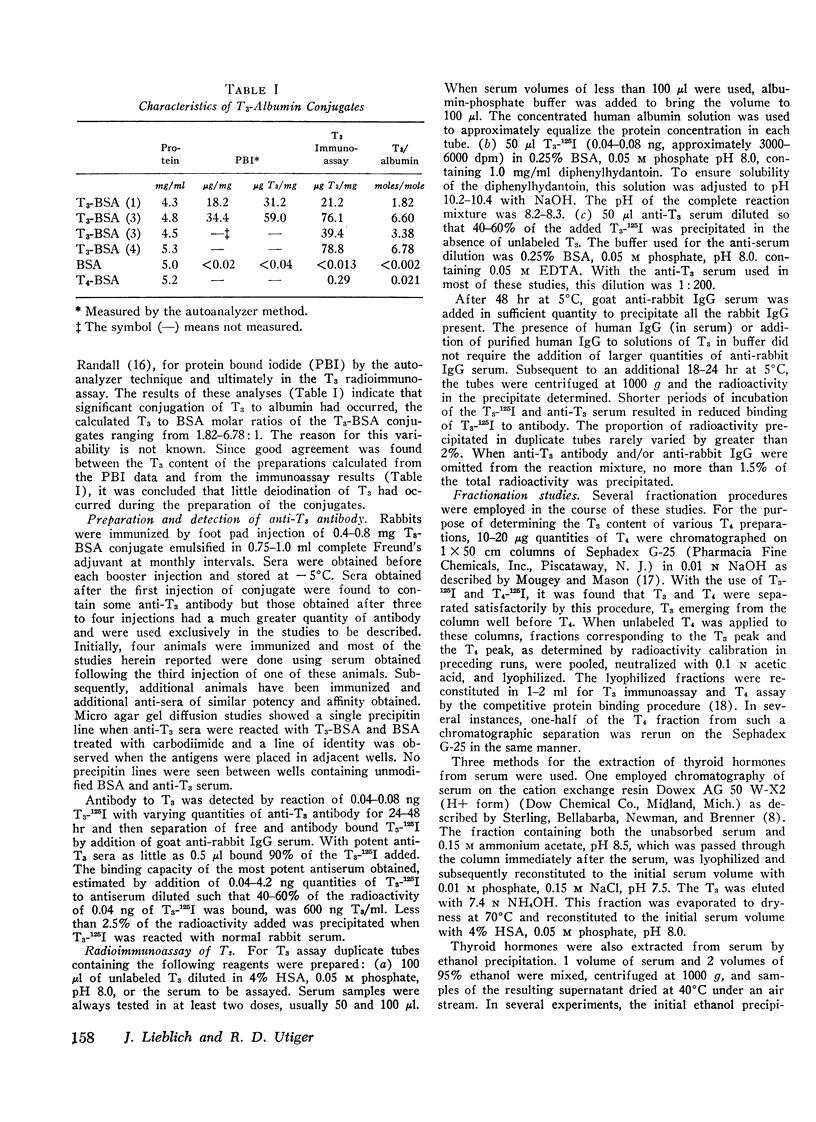
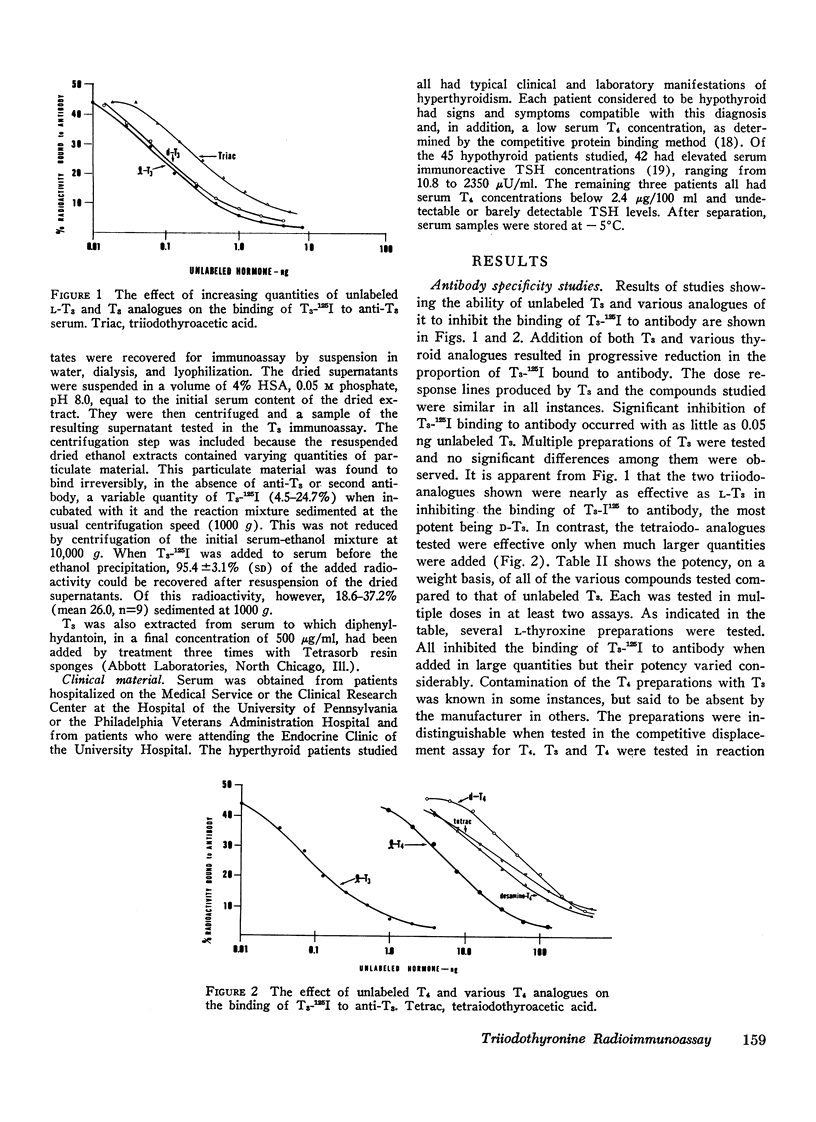
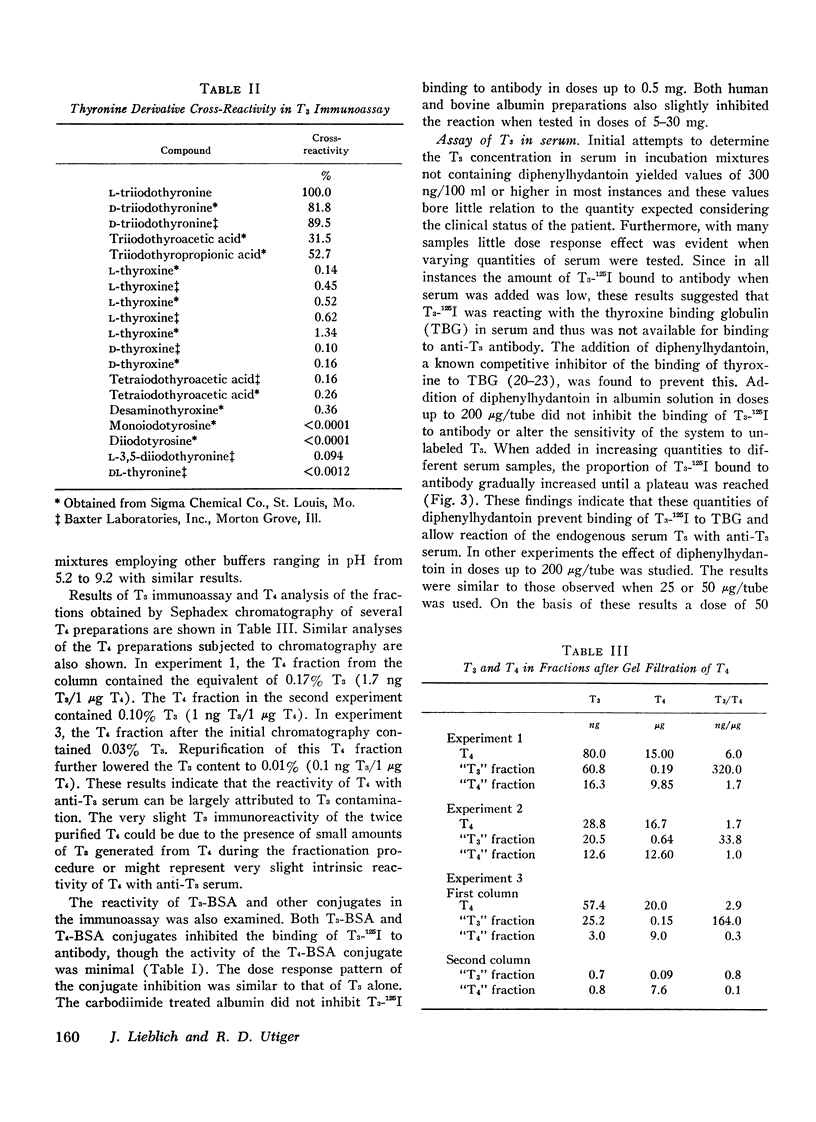


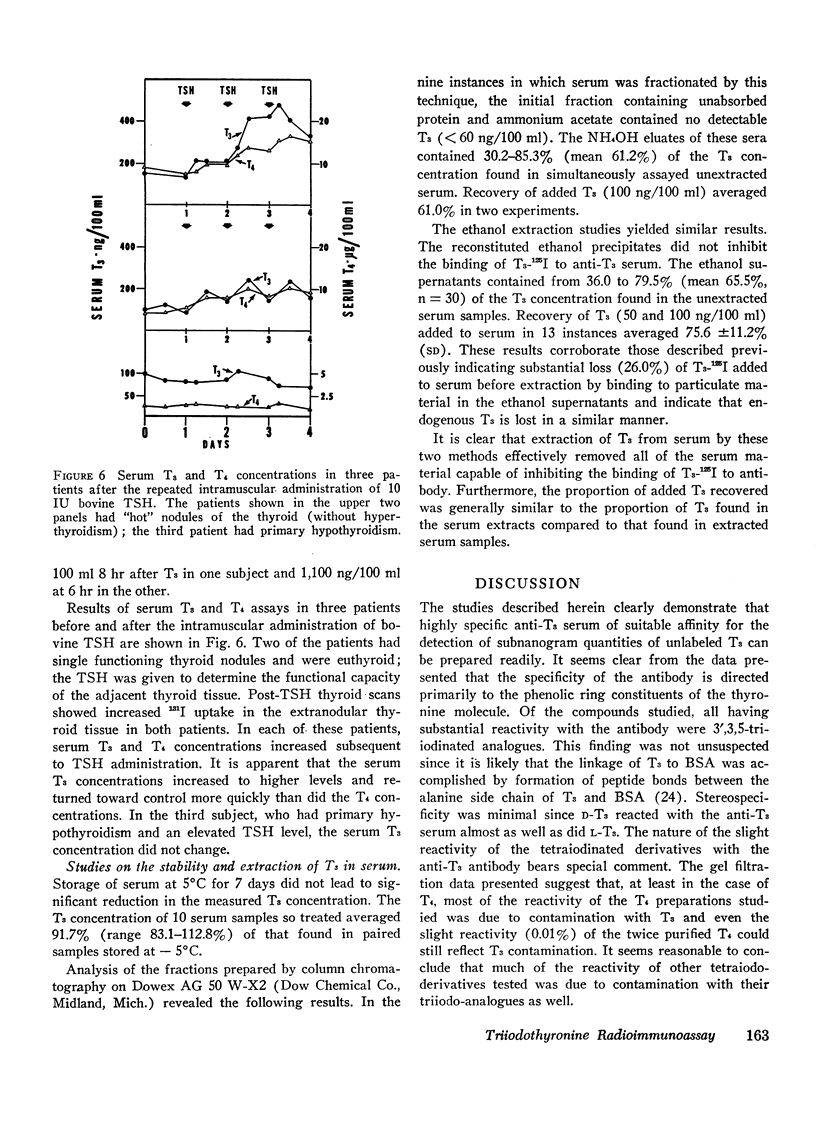
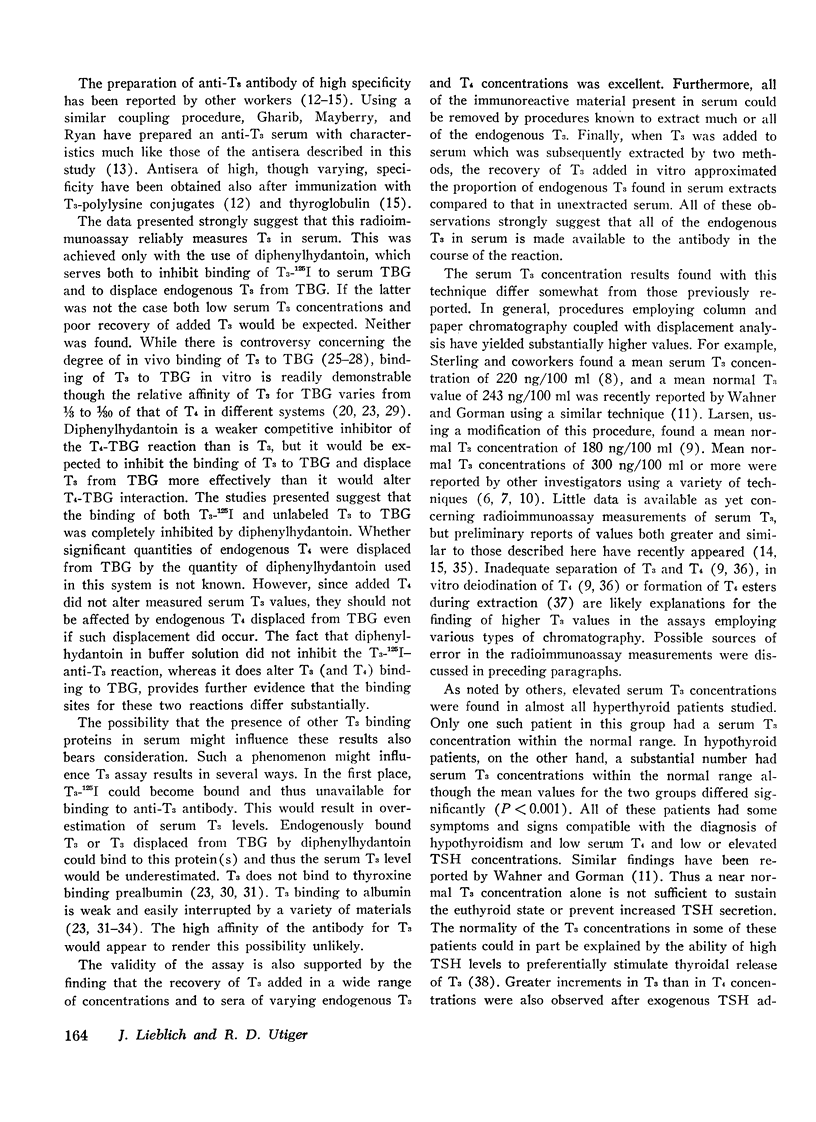
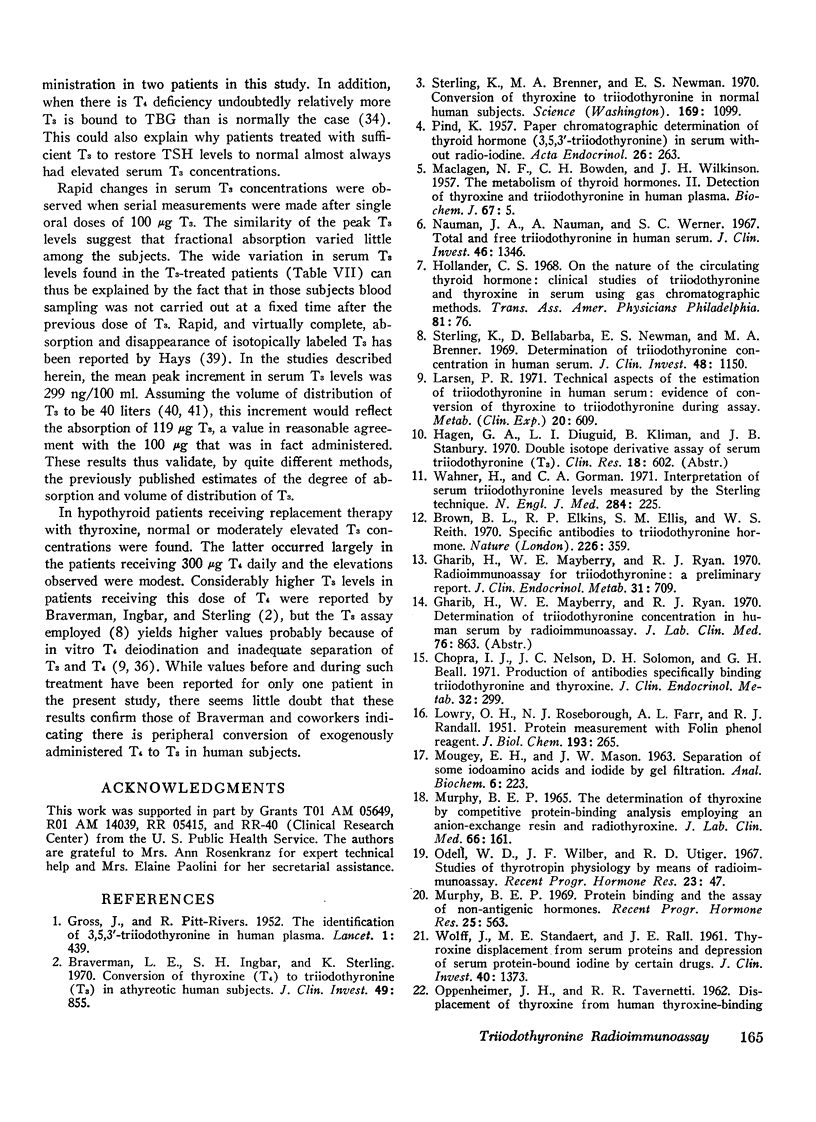
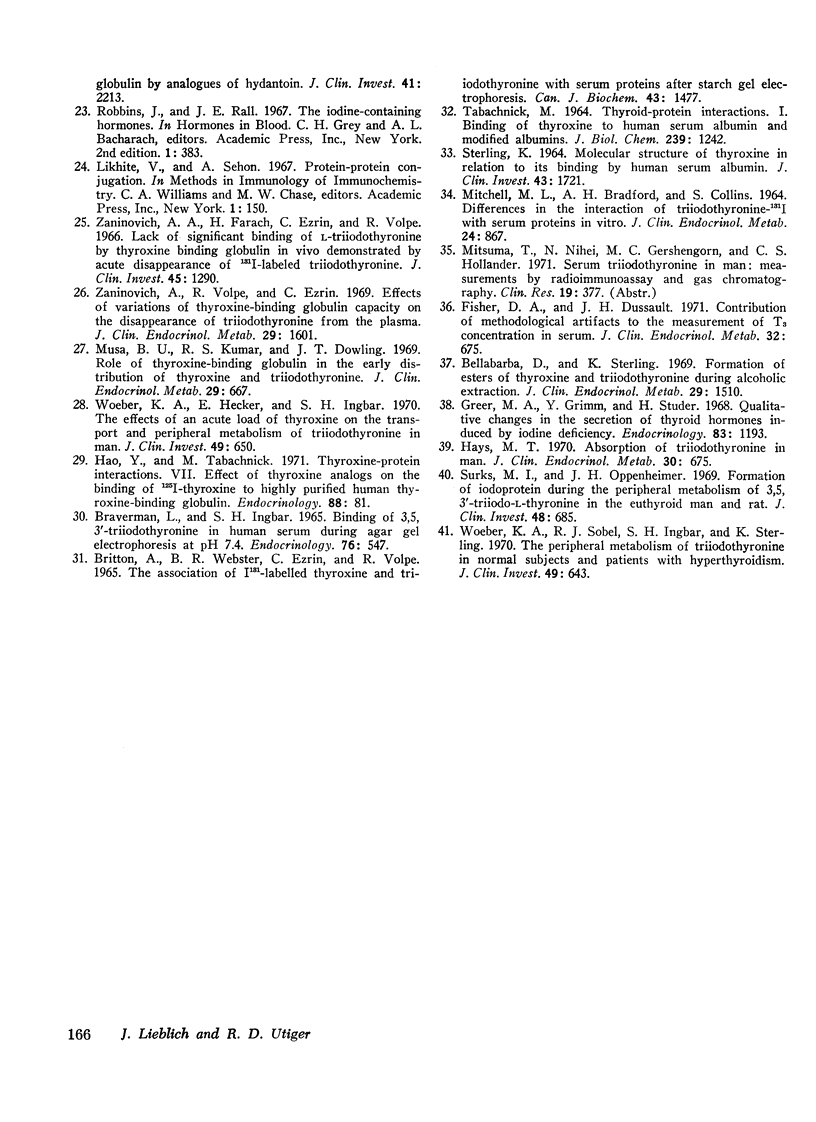
Selected References
These references are in PubMed. This may not be the complete list of references from this article.
- BRAVERMAN L. E., INGBAR S. H. BINDING OF 3,5,3' -L-TRIIODOTHYRONINE IN HUMAN SERUM DURING AGAR GEL ELECTROPHORESIS AT PH 7.4. Endocrinology. 1965 Mar;76:547–549. doi: 10.1210/endo-76-3-547. [DOI] [PubMed] [Google Scholar]
- Bellabarba D., Sterling K. Formation of ester of thyroxine and triiodothyronine during alcoholic extraction. J Clin Endocrinol Metab. 1969 Nov;29(11):1510–1513. doi: 10.1210/jcem-29-11-1510. [DOI] [PubMed] [Google Scholar]
- Braverman L. E., Ingbar S. H., Sterling K. Conversion of thyroxine (T4) to triiodothyronine (T3) in athyreotic human subjects. J Clin Invest. 1970 May;49(5):855–864. doi: 10.1172/JCI106304. [DOI] [PMC free article] [PubMed] [Google Scholar]
- Britton A., Webster B. R., Ezrin C., Volpe R. The association of I-131-labelled thyroxine and triiodothyronine with serum proteins after starch gel electrophoresis. Can J Biochem. 1965 Sep;43(9):1477–1487. doi: 10.1139/o65-166. [DOI] [PubMed] [Google Scholar]
- Brown B. L., Ekins R. P., Ellis S. M., Reith W. S. Specific antibodies to triiodothyronine hormone. Nature. 1970 Apr 25;226(5243):359–359. doi: 10.1038/226359a0. [DOI] [PubMed] [Google Scholar]
- Chopra I. J., Nelson J. C., Solomon D. H., Beall G. N. Production of antibodies specifically binding triiodothyronine and thyroxine. J Clin Endocrinol Metab. 1971 Mar;32(3):299–308. doi: 10.1210/jcem-32-3-299. [DOI] [PubMed] [Google Scholar]
- Fisher D. A., Dussault J. H. Contribution of methodological artifacts to the measurement of T3 concentration in serum. J Clin Endocrinol Metab. 1971 May;32(5):675–679. doi: 10.1210/jcem-32-5-675. [DOI] [PubMed] [Google Scholar]
- GROSS J., PITT-RIVERS R. The identification of 3:5:3'-L-triiodothyronine in human plasma. Lancet. 1952 Mar 1;1(6705):439–441. doi: 10.1016/s0140-6736(52)91952-1. [DOI] [PubMed] [Google Scholar]
- Gharib H., Mayberry W. E., Ryan R. J. Radioimmunoassay for triiodothyronine: A preliminary report. J Clin Endocrinol Metab. 1970 Dec;31(6):709–712. doi: 10.1210/jcem-31-6-709. [DOI] [PubMed] [Google Scholar]
- Greer M. A., Grimm Y., Studer H. Qualitative changes in the secretion of thyroid hormones induced by iodine deficiency. Endocrinology. 1968 Dec;83(6):1193–1198. doi: 10.1210/endo-83-6-1193. [DOI] [PubMed] [Google Scholar]
- Hao Y. L., Tabachnick M. Thyroxine-protein interactions. VII. Effect of thyroxine analogs on the binding of 125-I-thyroxine to highly purified human thyroxine-binding globulin. Endocrinology. 1971 Jan;88(1):81–92. doi: 10.1210/endo-88-1-81. [DOI] [PubMed] [Google Scholar]
- Hays M. T. Absorption of triiodothyronine in man. J Clin Endocrinol Metab. 1970 May;30(5):675–676. doi: 10.1210/jcem-30-5-675. [DOI] [PubMed] [Google Scholar]
- Hollander C. S. On the nature of the circulating thyroid hormone: clinical studies of triiodothyronine and thyroxine in serum using gas chromatographic methods. Trans Assoc Am Physicians. 1968;81:76–91. [PubMed] [Google Scholar]
- LOWRY O. H., ROSEBROUGH N. J., FARR A. L., RANDALL R. J. Protein measurement with the Folin phenol reagent. J Biol Chem. 1951 Nov;193(1):265–275. [PubMed] [Google Scholar]
- Larsen P. R. Technical aspects of the estimation of triiodothyronine in human serum: evidence of conversion of thyroxine to triiodothyronine during assay. Metabolism. 1971 Jun;20(6):609–624. doi: 10.1016/0026-0495(71)90009-6. [DOI] [PubMed] [Google Scholar]
- MACLAGAN N. F., BOWDEN C. H., WILKINSON J. H. The metabolism of thyroid hormones. 2. Detection of thyroxine and tri-iodothyronine in human plasma. Biochem J. 1957 Sep;67(1):5–11. doi: 10.1042/bj0670005. [DOI] [PMC free article] [PubMed] [Google Scholar]
- MITCHELL M. L., BRADFORD A. H., COLLINS S. DIFFERENCES IN THE INTERACTION OF TRIIODOTHYRONINE-131-I WITH SERUM PROTEINS IN VITRO. J Clin Endocrinol Metab. 1964 Sep;24:867–874. doi: 10.1210/jcem-24-9-867. [DOI] [PubMed] [Google Scholar]
- MOUGEY E. H., MASON J. W. SEPARATION OF SOME IODOAMINO ACIDS AND IODIDE BY GEL FILTRATION. Anal Biochem. 1963 Sep;6:223–233. doi: 10.1016/0003-2697(63)90129-5. [DOI] [PubMed] [Google Scholar]
- Murphy B. E. Protein binding and the assay of nonantigenic hormones. Recent Prog Horm Res. 1969;25:563–610. doi: 10.1016/b978-0-12-571125-8.50016-8. [DOI] [PubMed] [Google Scholar]
- Musa B. U., Kumar R. S., Dowling J. T. Role of thyroxine-binding globulin in the early distribution of thyroxine and triiodothyronine. J Clin Endocrinol Metab. 1969 May;29(5):667–674. doi: 10.1210/jcem-29-5-667. [DOI] [PubMed] [Google Scholar]
- Nauman J. A., Nauman A., Werner S. C. Total and free triiodothyronine in human serum. J Clin Invest. 1967 Aug;46(8):1346–1355. doi: 10.1172/JCI105627. [DOI] [PMC free article] [PubMed] [Google Scholar]
- OPPENHEIMER J. H., TAVERNETTI R. R. Displacement of thyroxine from human thyroxine-binding globulin by analogues of hydantoin. Steric aspects of the thyroxinebinding site. J Clin Invest. 1962 Dec;41:2213–2220. doi: 10.1172/JCI104680. [DOI] [PMC free article] [PubMed] [Google Scholar]
- Odell W. D., Wilber J. F., Utiger R. D. Studies of thyrotropin physiology by means of radioimmunoassay. Recent Prog Horm Res. 1967;23:47–85. doi: 10.1016/b978-1-4831-9826-2.50005-2. [DOI] [PubMed] [Google Scholar]
- PIND K. Paperchromatographic determination of thyroid hormone (3,5,3'-triiodothyronine) in serum without radio-iodine. Acta Endocrinol (Copenh) 1957 Nov;26(3):263–272. doi: 10.1530/acta.0.0260263. [DOI] [PubMed] [Google Scholar]
- STERLING K. MOLECULAR STRUCTURE OF THYROXINE IN RELATION TO ITS BINDING BY HUMAN SERUM ALBUMIN. J Clin Invest. 1964 Sep;43:1721–1729. doi: 10.1172/JCI105047. [DOI] [PMC free article] [PubMed] [Google Scholar]
- Sterling K., Bellabarba D., Newman E. S., Brenner M. A. Determination of triiodothyronine concentration in human serum. J Clin Invest. 1969 Jun;48(6):1150–1158. doi: 10.1172/JCI106072. [DOI] [PMC free article] [PubMed] [Google Scholar]
- Sterling K., Brenner M. A., Newman E. S. Conversion of thyroxine to triiodothyronine in normal human subjects. Science. 1970 Sep 11;169(3950):1099–1100. doi: 10.1126/science.169.3950.1099. [DOI] [PubMed] [Google Scholar]
- Surks M. I., Oppenheimer J. H. Formation of iodoprotein during the peripheral metabolism of 3,5,3'-triiodo-L-thyronine-125I in the euthyroid man and rat. J Clin Invest. 1969 Apr;48(4):685–695. doi: 10.1172/JCI106026. [DOI] [PMC free article] [PubMed] [Google Scholar]
- TABACHNICK M. THYROXINE-PROTEIN INTERACTIONS. I. BINDING OF THYROXINE TO HUMAN SERUM ALBUMIN AND MODIFIED ALBUMINS. J Biol Chem. 1964 Apr;239:1242–1249. [PubMed] [Google Scholar]
- WOLFF J., STANDAERT M. E., RALL J. E. Thyroxine displacement from serum proteins and depression of serum protein-bound iodine by certain drugs. J Clin Invest. 1961 Aug;40:1373–1379. doi: 10.1172/JCI104368. [DOI] [PMC free article] [PubMed] [Google Scholar]
- Wahner H. W., Gorman C. A. Interpretation of serum tri-iodothyronine levels measured by the sterling technic. N Engl J Med. 1971 Feb 4;284(5):225–230. doi: 10.1056/NEJM197102042840501. [DOI] [PubMed] [Google Scholar]
- Woeber K. A., Hecker E., Ingbar S. H. The effects of an acute load of thyroxine on the transport and peripheral metabolism of triiodothyronine in man. J Clin Invest. 1970 Apr;49(4):650–654. doi: 10.1172/JCI106276. [DOI] [PMC free article] [PubMed] [Google Scholar]
- Woeber K. A., Sobel R. J., Ingbar S. H., Sterling K. The peripheral metabolism of triiodothyronine in normal subjects and in patients with hyperthyroidism. J Clin Invest. 1970 Apr;49(4):643–649. doi: 10.1172/JCI106275. [DOI] [PMC free article] [PubMed] [Google Scholar]
- Zaninovich A. A., Farach H., Ezrin C., Volpé R. Lack of significant binding of L-triiodothyronine by thyroxine-binding globulin in vivo as demonstrated by acute disappearance of 131-I-labeled triiodothyronine. J Clin Invest. 1966 Aug;45(8):1290–1301. doi: 10.1172/JCI105436. [DOI] [PMC free article] [PubMed] [Google Scholar]
- Zaninovich A. A., Volpe R., Ezrin C. Effects of variations of thyroxine-binding globulin capacity on the disappearance of triiodothyronine from the plasma. J Clin Endocrinol Metab. 1969 Dec;29(12):1601–1607. doi: 10.1210/jcem-29-12-1601. [DOI] [PubMed] [Google Scholar]


